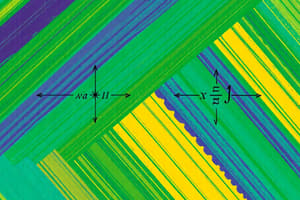Podcast
Questions and Answers
What form should be used to find the equation of a line passing through two given points?
What form should be used to find the equation of a line passing through two given points?
- Point-slope form
- Two-point form (correct)
- Slope-intercept form
- Y-intercept form
If the slope of a line is negative, how does the line slant?
If the slope of a line is negative, how does the line slant?
- Upward from left to right
- Downward from left to right (correct)
- It doesn't actually slant
- Horizontally
In linear equations, if the y-intercept is positive, where does the line cross the y-axis?
In linear equations, if the y-intercept is positive, where does the line cross the y-axis?
- At a negative value
- At zero
- At a positive value (correct)
- It doesn't cross the y-axis
Which form should be used to find an equation of a line that passes through a given point and has a specific slope?
Which form should be used to find an equation of a line that passes through a given point and has a specific slope?
If the slope of a line is zero, how does the line appear?
If the slope of a line is zero, how does the line appear?
What should you do first when graphing a linear equation?
What should you do first when graphing a linear equation?
What is the standard form of a linear equation in two variables?
What is the standard form of a linear equation in two variables?
Which method involves plotting points and finding the best-fitting line to determine a linear equation?
Which method involves plotting points and finding the best-fitting line to determine a linear equation?
What is the simplest form of a linear equation in two variables?
What is the simplest form of a linear equation in two variables?
In a linear equation, what does the variable 'm' represent in the equation y = mx + b?
In a linear equation, what does the variable 'm' represent in the equation y = mx + b?
Which method involves replacing the value of one variable with the other to solve a linear equation?
Which method involves replacing the value of one variable with the other to solve a linear equation?
How do linear equations with two variables represent relationships?
How do linear equations with two variables represent relationships?
Flashcards are hidden until you start studying
Study Notes
Linear Equations with Two Variables
Linear equations with two variables are fundamental to the understanding of algebra and geometry. These equations represent relationships between two variables, often referred to as x- and _y-_values in a coordinate plane. Let's explore these equations in more detail and learn how to identify, graph, and solve them.
Identifying Linear Equations
A linear equation in two variables is a function that can be written in the form of Ax + By = C, where (A) and (B) are constants, and (x) and (y) are the variables. The simplest form of a linear equation is y = mx + b, where (m) is the slope and (b) is the y-intercept.
Solving Linear Equations
There are several methods to solve linear equations with two variables:
-
Substitution method: Replace the value of one variable in terms of the other in the equation and then solve for the remaining variable.
-
Elimination method: Simplify the equation by eliminating one of the variables and then solve for the remaining variable.
-
Graphical method: Plot the points of the system and find the line that best fits the points to determine the linear equation.
-
Substitution into the standard form: Write the equation in the form of Ax + By = C and then solve for one variable using the value of the other variable.
Applications of Linear Equations
Linear equations have practical applications in real-world scenarios. Some examples include:
-
Slope-intercept form: y = mx + b can be used to model linear relationships, such as the price of a product after a sale or the speed of a moving object.
-
Point-slope form: y - y1 = m(x - x1) can be used to find an equation of a line that passes through a given point and has a specific slope.
-
Two-point form: y - y1 = m(x - x1) can be used to find the equation of a line passing through two given points.
Graphing Linear Equations
After identifying a linear equation, we can graph it on a coordinate plane to visualize the relationship between the variables. To graph a linear equation, follow these steps:
- Identify the slope and y-intercept of the equation.
- Plot the y-intercept point and move one unit to the right to find the slope-intercept point.
- Connect the two points with a straight line.
When graphing a linear equation, note the following:
- If the slope is positive, the line slants upward from left to right.
- If the slope is negative, the line slants downward from left to right.
- If the slope is zero, the line is horizontal.
- If the y-intercept is positive, the line crosses the y-axis at a positive value.
- If the y-intercept is negative, the line crosses the y-axis at a negative value.
- If the y-intercept is zero, the line passes through the origin.
Linear equations with two variables are fundamental to algebra and geometry, and they have numerous applications in real-world scenarios. Understanding these equations will provide a solid foundation for more advanced topics in mathematics and beyond.
Studying That Suits You
Use AI to generate personalized quizzes and flashcards to suit your learning preferences.




